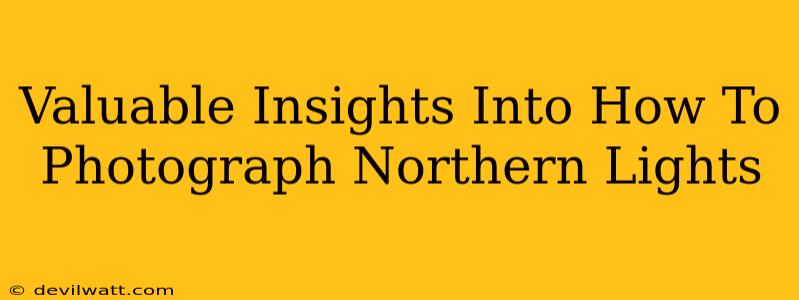Chasing the Aurora Borealis, that ethereal dance of light across the night sky, is a bucket-list dream for many photographers. But capturing its magic on camera requires more than just pointing and shooting. This guide dives into the valuable insights you need to photograph the Northern Lights successfully, turning fleeting moments of wonder into breathtaking images you'll cherish forever.
Planning Your Aurora Photography Adventure
Before you even think about pressing the shutter, meticulous planning is key to Northern Lights photography success.
1. Knowing When and Where to Go:
The Northern Lights, or Aurora Borealis, are most visible in high-latitude regions, primarily around the Arctic Circle. Places like Iceland, Norway, Alaska, Canada, and Greenland are prime locations. The best time to see them is during the winter months (September to April) when nights are long and dark. Check aurora forecasts – websites and apps provide predictions based on solar activity. The KP index is your friend; a higher KP number indicates a stronger aurora display.
2. Choosing the Right Location:
Light pollution is the enemy of aurora photography. Escape city lights and find dark locations away from artificial illumination. Consider landscapes that complement the aurora – mountains, forests, water, even snow-covered fields can create stunning compositions. Scout your locations beforehand if possible, noting ideal viewpoints and potential obstacles.
3. Essential Gear for Aurora Photography:
- Camera: A DSLR or mirrorless camera with manual settings is essential.
- Wide-Angle Lens: A wide-angle lens (14mm-24mm) is crucial to capture the vastness of the aurora.
- Sturdy Tripod: Essential for long exposures, a robust tripod is a non-negotiable.
- Remote Shutter Release: Minimizes camera shake during long exposures.
- Extra Batteries: Cold temperatures drain batteries quickly.
- Headlamp: Essential for navigating in the dark, but use a red light setting to preserve your night vision.
- Warm Clothing: Prepare for cold, potentially harsh weather conditions.
Mastering the Art of Aurora Photography
Now for the fun part – actually capturing those dancing lights!
1. Camera Settings:
- Manual Mode (M): Take control of your aperture, shutter speed, and ISO.
- Aperture (f/2.8 - f/4): A wide aperture lets in maximum light.
- ISO: Start around 800 and adjust based on the aurora's brightness. Higher ISO values increase sensitivity, but can introduce noise.
- Shutter Speed: This will vary based on the intensity of the aurora and your ISO. Experiment to find the best balance between capturing the aurora's movement and avoiding excessive blur. Start with 10-30 seconds and adjust accordingly.
- Focus: Set your lens to manual focus and focus to infinity.
2. Composition and Framing:
Don't just point your camera at the sky! Incorporate foreground elements to add depth and interest to your images. Think about leading lines, interesting shapes, and textures in the landscape. The rule of thirds can help you create visually appealing compositions.
3. Capturing the Movement:
The aurora is dynamic; its movements can be subtle or dramatic. Experiment with different shutter speeds to capture its shifting patterns. Longer exposures capture more of the aurora's movement, resulting in smoother, flowing light. Shorter exposures will "freeze" the aurora's movement, revealing more detail.
4. Post-Processing:
Post-processing can enhance your aurora images. Software like Adobe Lightroom or Photoshop can help you adjust brightness, contrast, and saturation. Noise reduction can minimize graininess, particularly at higher ISO settings. However, avoid over-processing; aim for a natural, stunning look.
Off-Page SEO for Aurora Photography Content
- Build high-quality backlinks: Guest posting on relevant photography blogs or travel websites can help boost your article's search engine ranking.
- Social Media Promotion: Share your article and stunning aurora photos on platforms like Instagram, Facebook, and Pinterest. Use relevant hashtags to increase visibility.
- Collaborate with other photographers: Cross-promotion can broaden your reach and attract a wider audience.
- Engage with your audience: Respond to comments and questions on your article and social media posts. This increases engagement and signals relevance to search engines.
By combining these on-page and off-page SEO strategies with stunning visuals, you'll not only attract readers eager to learn about photographing the Northern Lights, but also position your content as a valuable resource for aspiring aurora photographers. Remember to be patient, persistent, and above all, to enjoy the magical experience of witnessing the aurora borealis itself!

